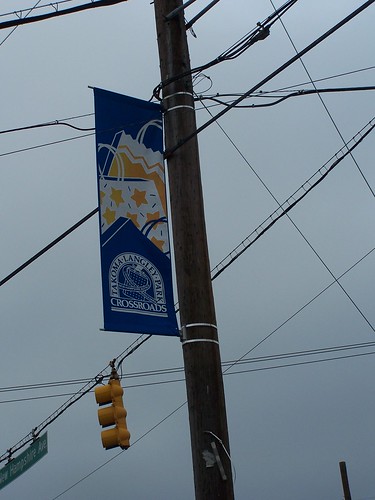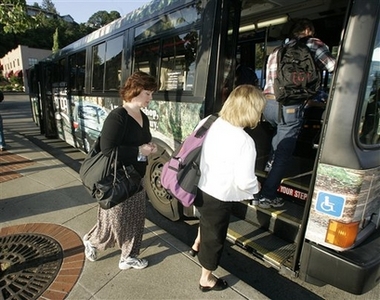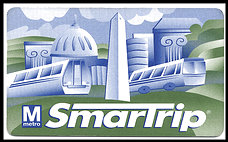The Purple Line and the "Mobility" Shed
You may recall that I have been writing about my idea of what I call the mobility or the transit shed, and how to plan and execute transportation planning within that "shed" in order to get more people using transit.
It came up again in my comments to the Bacon's Rebellion piece in response to the Post's editorial about the Purple Line, "Going Purple," where one Fairfax "advocate" was quoted by someone as saying that the problem with using transit in Fairfax is that there isn't enough parking. Really, the issue is figuring out how to best get people on the system, without having to use a car to do so. (Thinking car-centrically in this case is no different than the story about the person with a hammer who sees all problems as nails.)
And as I repeat until I am blue in the face, one of the best examples around is Montgomery County Maryland, and how they designed their bus system to collect people in neighborhoods and deposit them at subway stations, by providing bus service and pick up points so that no part of a neighborhood is farther than 1/4 mile from a bus stop (this is an easy five minute walk). And I wrote a couple blog entries in March 2005, when I was still enthralled with the "Dr. Transit" guise, about this in relation to both Fairfax County and the Virginia Railway Express.
Today's Post has an excerpt from Steven Ginsberg's blog Get There, in place of the Dr. Gridlock column, which is on hiatus pending a replacement for Ron Shaffner. The piece, "Keep the Traffic Queries Coming," recounts a tour he took of the proposed Purple Line, along with other journalists I presume, and various public officials. One of the the comments reprinted in the paper is from someone who said that (1) the proposed line won't decrease car usage; and (2) it won't improve areas like Langley Park and New Carrollton.
Well, given how godawful Langley Park is, at least in the vicinity of University Blvd. and New Hampshire Avenue, I think that's impossible. (And the parts of "New Carrollton" that I've been in, fortunately few in number, have a great deal of room for sound urban design driven improvement.)
In fact, with decent transit in the mix, a redesign and densification along the lines of Bethesda Row isn't out of the question. There is tremendous opportunity. One could develop a great Latino-oriented mixed-use downtown "Centro de Oro" or a development along the lines of the Fruitvale Transit-Oriented Development project in Oakland, California, but better.
In fact, if Montgomery and PG Counties created a transit TIF district here to capture increases in value derived from the Purple Line transit system, it could go a long way towards paying for the construction of the system. And this is just one of the areas that will be impacted by the system.
 Fruitvale Village, Oakland, California.
Fruitvale Village, Oakland, California. From a built environment urban design standpoint, Langley Park, Maryland is as pathetic as this placeless banner.
From a built environment urban design standpoint, Langley Park, Maryland is as pathetic as this placeless banner.Getting back to the transit/mobility shed idea, what it takes are incentives and planning and execution to get people out of their cars. It can be done, as this AP story about Portland, Oregon makes clear, "Subsidies are swaying commuters to drive less." From the article:
For 20 years, Martha Fitts drove 32 miles a day to her job, guzzling, in total, about 6,000 gallons of gasoline. At today's prices, that's worth nearly $18,000. This year, Fitts' employer hiked its monthly transportation subsidy from $30 to $70, and the mother of two realized she could get to work virtually for free if she took the bus. On June 1, she started leaving her Nissan Maxima at home, and estimates she'll save about $250 to $300 a month by not paying for gas or parking. Her commute time has lengthened from 40 minutes to about 55 minutes.
 Martha Fitts, left, is seen commuting to work by bus Friday, June 30, 2006, in Portland, Ore. Fitts has worked for Regence 20 years, and just started taking the bus this month when she got fed up paying so much for gas. (AP Photo/Rick Bowmer).
Martha Fitts, left, is seen commuting to work by bus Friday, June 30, 2006, in Portland, Ore. Fitts has worked for Regence 20 years, and just started taking the bus this month when she got fed up paying so much for gas. (AP Photo/Rick Bowmer).Incentives make the world go round. As long as people get free parking, and other inducements to drive, they will drive. Until the price of gas rises or other exogenous shocks arise, impacting their routine and providing a moment, an opportunity for change. All the inducements and subsidies have favored automobile driving. Now with increased demand for oil, whether or not you believe in "peak oil," prices are going to stay higher, and people are going to start making smarter choices about transportation.
Speaking of marketing, one of the suggestions in the Georgia Avenue Rapid Bus Transit meeting was to provide free SmarTrip cards to people in the neighborhood, to encourage them to ride the new Rapid Bus. The cards could be branded, to further strengthen the identity. (Plus, they help people alight faster. Paying with change and wrinkled dollars slows the boarding process.)

Focused transit planning and marketing initiatives can change how people perceive transit, in an environment that still promotes automobile-centricity. E.g., how about free wi-fi on the Purple Line?
Index Keywords: transit



0 Comments:
Post a Comment
<< Home